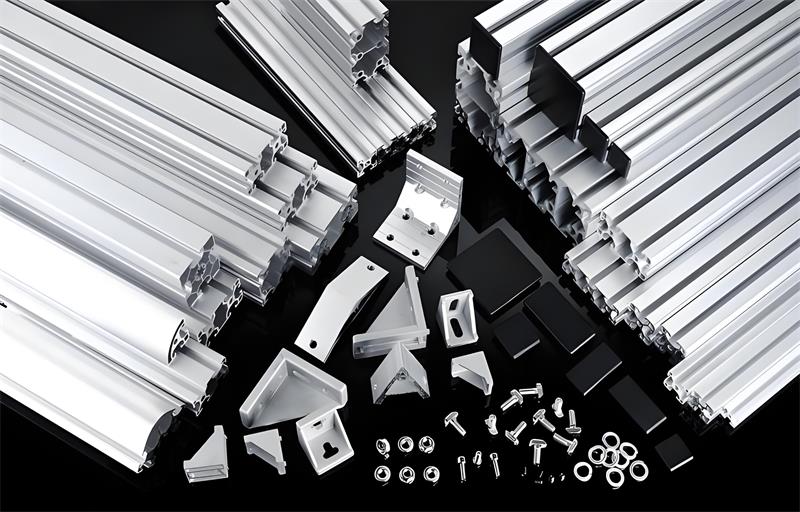What Is the Most Common Aluminium Profile?

What Is the Most Common Aluminium Profile?
Aluminium has become one of the most versatile and widely used materials across industries, from construction to automotive manufacturing and beyond. Among the many forms of aluminium products, aluminium profiles stand out as some of the most important components in modern engineering and design.
But what exactly is the most common aluminium profile? Why is it so frequently used, and what are its benefits? In this article, we’ll take a deep dive into aluminium profiles, focusing on the most common variants, their properties, and how industries around the world, including companies like Aluinno Aluminum, rely on them for everything from window frames to vehicle components.
Table of Contents
| Sr# | Headings |
| 1 | Introduction |
| 2 | What Are Aluminium Profiles? |
| 3 | 6063 Aluminium Profile: The Most Common Type |
| 4 | Why 6063 Aluminium Profiles Are Popular |
| 5 | Durability and Strength of Aluminium Profiles |
| 6 | Lightweight Advantage |
| 7 | Corrosion Resistance |
| 8 | Design Flexibility |
| 9 | Sustainability and Recyclability |
| 10 | Thermal Efficiency |
| 11 | Applications in Construction |
| 12 | Uses in the Automotive Industry |
| 13 | Furniture and Interior Design |
| 14 | Low Maintenance Requirements |
| 15 | Role of Aluinno Aluminum in the Industry |
| 16 | Advances in Aluminium Profile Technology |
| 17 | Aluminium Profiles vs. Other Materials |
| 18 | Conclusion |
| 19 | FAQs |
Introduction
Aluminium profiles are an essential component in countless industries today. Whether you’re an engineer working on a construction project or a designer crafting modern furniture, chances are you’ve worked with aluminium profiles in one way or another. They offer numerous benefits, from lightweight durability to customizable designs, making them ideal for a wide range of applications.
The 6063 aluminium profile is widely considered the most common and versatile of all aluminium profiles. In this article, we’ll explore what makes 6063 the go-to choice for various industries, how it compares to other profiles, and why companies like Aluinno Aluminum are leading the charge in developing and producing high-quality aluminium profiles that meet diverse needs.
What Are Aluminium Profiles?
Aluminium profiles are extruded products made from aluminium alloys. The extrusion process involves heating aluminium and pushing it through a die to create specific shapes, such as bars, tubes, frames, and customized designs. The versatility of aluminium makes it ideal for creating profiles that can be used for a wide range of structural and aesthetic purposes.
Aluminium profiles are available in many different shapes and sizes, depending on the needs of the application. They are often used in windows, doors, curtain walls, railings, furniture, vehicle components, and more. The flexibility in design allows engineers and architects to create profiles that meet precise requirements while benefiting from the material's inherent properties, such as strength, lightweight, and corrosion resistance.
6063 Aluminium Profile: The Most Common Type
The 6063 aluminium profile is by far the most commonly used profile in industries around the world. Often referred to as an "architectural aluminium" alloy, 6063 offers the perfect balance of strength, corrosion resistance, surface finish, and workability.
The 6063 T5 and 6063 T6 versions are particularly popular, with T5 being the standard grade for most structural and architectural applications, and T6 offering slightly enhanced strength through additional heat treatment. This alloy is known for its smooth finish, which makes it ideal for products that require anodizing, painting, or polishing, ensuring both aesthetic appeal and functionality.
Applications of 6063 Aluminium Profile
The 6063 aluminium profile is most commonly found in window frames, door frames, curtain walls, railings, and furniture components. Its ability to form complex shapes while maintaining strength and resistance to environmental factors makes it the top choice for both indoor and outdoor applications.
Why 6063 Aluminium Profiles Are Popular
So, what makes the 6063 aluminium profile the most common? Several factors contribute to its popularity across industries:
1. Excellent Surface Finish: The 6063 alloy produces a smooth surface, which can be anodized or coated for enhanced aesthetics and durability.
2. Workability: 6063 is highly malleable, making it easier to extrude into complex shapes and custom designs.
3. Corrosion Resistance: The alloy naturally forms an oxide layer when exposed to air, protecting it from corrosion and making it suitable for outdoor use.
4. Cost-Effective: 6063 offers a great balance of strength, workability, and price, making it a cost-effective option for manufacturers.
5. Strength-to-Weight Ratio: It provides sufficient strength for structural applications without adding unnecessary weight.
Durability and Strength of Aluminium Profiles
One of the key reasons aluminium profiles, particularly the 6063 variant, are so widely used is their impressive durability and strength-to-weight ratio. Aluminium profiles can support heavy loads without being overly cumbersome, making them ideal for structural applications where both lightweight and strength are required.
The 6063 aluminium profile offers excellent mechanical properties, ensuring that it can withstand pressure, impacts, and stress over time. While other metals like steel may offer more strength, the lightweight nature of aluminium and its ability to be easily shaped without compromising structural integrity make it a preferred choice in many applications.
Lightweight Advantage
A major benefit of aluminium profiles is their lightweight nature, which sets them apart from heavier materials like steel. Aluminium weighs about one-third as much as steel, making it easier to transport, handle, and install. This weight advantage is especially crucial in industries like construction and automotive, where weight reduction can lead to lower transportation costs, faster assembly, and improved fuel efficiency in vehicles.
The 6063 aluminium profile maintains this lightweight advantage while providing the necessary strength for load-bearing applications. It’s frequently used in building facades, window frames, and vehicle parts because it reduces overall weight without sacrificing durability.
Corrosion Resistance
Another standout feature of aluminium profiles is their corrosion resistance. When aluminium is exposed to air, it naturally forms a thin layer of oxide that protects the metal from further oxidation. This property makes aluminium profiles ideal for outdoor use, especially in environments where exposure to moisture or saltwater can cause rusting in other metals.
The 6063 aluminium profile is highly resistant to corrosion, making it perfect for marine environments, building exteriors, and industrial settings. This low-maintenance aspect reduces the need for frequent repairs or replacements, saving time and money in the long run.
Design Flexibility
Aluminium is known for its malleability, allowing it to be extruded into a variety of shapes, from simple bars to complex, intricate designs. This makes aluminium profiles an excellent choice for applications requiring a customized approach. Whether for architectural features, furniture, or industrial components, aluminium profiles can be tailored to meet the specific needs of a project.
The 6063 aluminium profile is particularly valued for its design flexibility, as it can be easily formed into precise shapes without compromising its strength. Architects, designers, and engineers favor this alloy for its ability to take on creative designs while providing the necessary structural support.
Sustainability and Recyclability
In today’s world, sustainability is a top priority for industries across the globe. Aluminium, as a material, stands out for its recyclability. Aluminium can be recycled indefinitely without losing its properties, and the recycling process requires only about 5% of the energy needed to produce new aluminium from raw materials. This makes aluminium profiles an environmentally friendly option for industries looking to reduce their carbon footprint.
6063 aluminium profiles are no exception, offering an eco-friendly solution for industries focused on sustainability. Recycling aluminium not only saves energy but also reduces waste, making it a responsible choice for manufacturers and consumers alike.
Thermal Efficiency
Aluminium profiles provide excellent thermal efficiency, making them an ideal material for energy-efficient building designs. When used in windows, doors, and curtain walls, aluminium profiles help reduce heat transfer between the interior and exterior of a building, which in turn improves insulation and reduces energy consumption.
Modern 6063 aluminium profiles are often designed with thermal breaks—insulating materials within the profile that minimize the transfer of heat. This innovation helps keep buildings cool in the summer and warm in the winter, contributing to lower energy bills and a more comfortable indoor environment.
Applications in Construction
In the construction industry, aluminium profiles have transformed the way buildings are designed and constructed. The 6063 aluminium profile is frequently used in window frames, door frames, building facades, and roof structures due to its lightweight nature and durability.
Aluminium profiles are also ideal for curtain walls—those large, non-load-bearing walls often seen on skyscrapers. Their corrosion resistance and ability to support complex shapes make them a perfect fit for both aesthetic and structural purposes in modern architecture.
Uses in the Automotive Industry
Aluminium profiles have gained significant traction in the automotive industry, particularly in the production of vehicle frames, chassis, and body panels. The lightweight properties of aluminium profiles help reduce the overall weight of vehicles, which leads to improved fuel efficiency and lower emissions.
The 6063 aluminium profile is commonly used in electric vehicles (EVs), where reducing weight is essential to extending the range of the vehicle. Additionally, aluminium profiles play a key role in crash management systems, where their ability to absorb impact helps enhance vehicle safety.
Furniture and Interior Design
Aluminium profiles have become a popular choice in furniture design and interior architecture. Their sleek, modern appearance makes them ideal for desks, chairs, shelves, partition systems, and decorative elements. Aluminium’s ability to be formed into custom shapes allows for creative designs that prioritize both aesthetics and functionality.
The 6063 aluminium profile is particularly suited for furniture applications, thanks to its smooth finish, ease of customization, and resistance to corrosion. Whether used in home décor or office environments, aluminium profiles provide a durable, low-maintenance solution that looks great in any setting.
Low Maintenance Requirements
One of the most appealing aspects of aluminium profiles is their low maintenance requirements. Unlike steel, which can rust, or wood, which can warp and decay, aluminium requires little to no upkeep. This is especially true for 6063 aluminium profiles, which are highly resistant to environmental wear and tear.
Aluminium window frames, for example, don’t need to be painted or sealed regularly, and they are not prone to warping like wooden frames. This makes aluminium profiles a great choice for outdoor applications and for industries that prioritize long-term durability with minimal maintenance.
Role of Aluinno Aluminum in the Industry
Aluinno Aluminum is a key player in the global aluminium industry, specializing in producing high-quality aluminium profiles for a variety of applications. From construction to automotive and furniture design, Aluinno Aluminum has earned a reputation for delivering innovative, durable, and cost-effective aluminium solutions.
Aluinno focuses on providing customized profiles that meet the specific needs of their clients. By working closely with architects, engineers, and designers, they ensure that their profiles meet the highest standards of strength, precision, and aesthetics.
Advances in Aluminium Profile Technology
The technology behind aluminium profiles has advanced significantly over the years, with companies like Aluinno Aluminum leading the way in research and development. Innovations in extrusion techniques, alloy compositions, and surface treatments have resulted in lighter, stronger, and more durable profiles.
New technologies have also expanded the possibilities for aluminium in industries like renewable energy, medical devices, and consumer electronics. As the demand for lightweight, durable materials continues to grow, aluminium profiles will likely play an even more prominent role in shaping the future of these industries.
Aluminium Profiles vs. Other Materials
When comparing aluminium profiles to other materials like steel, wood, or plastic, aluminium offers several key advantages. While steel is stronger, it’s much heavier and more prone to corrosion. Wood, on the other hand, requires regular maintenance and is susceptible to warping and decay.
Plastic is lightweight and inexpensive but lacks the strength and durability that aluminium offers. 6063 aluminium profiles strike the perfect balance of strength, weight, and resistance to corrosion, making them an ideal choice for a wide range of applications.
Conclusion
The 6063 aluminium profile has proven to be the most common and versatile profile in industries worldwide. Its strength, lightweight properties, corrosion resistance, and design flexibility make it the top choice for construction, automotive manufacturing, interior design, and more.
Companies like Aluinno Aluminum are at the forefront of the aluminium profile industry, providing customized solutions that meet the evolving needs of modern industries. With their commitment to innovation, sustainability, and precision, Aluinno Aluminum is helping shape the future of aluminium applications.
FAQs
1. Why is 6063 the most common aluminium profile?
The 6063 aluminium profile offers a balance of strength, corrosion resistance, and workability, making it ideal for various applications, from windows to vehicle components.
2. What are the main uses of 6063 aluminium profiles?
6063 aluminium profiles are commonly used in architectural applications such as window frames, door frames, and building facades, as well as in furniture and automotive components.
3. Can aluminium profiles be used outdoors?
Yes, aluminium profiles, particularly 6063, are highly resistant to corrosion, making them suitable for outdoor use in structures like windows, doors, and railings.
4. How are aluminium profiles made?
Aluminium profiles are made through an extrusion process where heated aluminium is pushed through a die to create specific shapes.
5. What are the environmental benefits of aluminium profiles?
Aluminium profiles are highly recyclable and can be reused indefinitely, reducing energy consumption and minimizing waste in the manufacturing process.


 En
En



 Location:
Location:
















